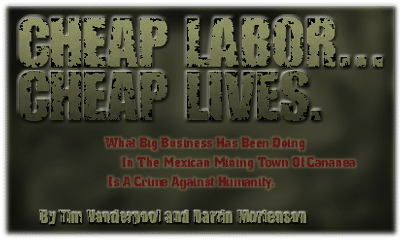
HISTORICAL IGNORANCE MAY be a token of doom. But even those
knee-deep in the past often fare little better. At least that's
the lesson learned by suffering workers at the legendary Cananea
mine in northern Sonora, when their recent strike was quashed
in favor of industrial titan Grupo Mexico.
On the other hand, the miners' ongoing struggle has tweaked fate
by enlisting an odd coalition of North American labor unionists,
human rights activists and environmentalists. The names ring familiar
locally, from Arizona Earth First!, the Southwest Center for Biodiversity
and Derechos Hermanos, to the AFL-CIO affiliated Southern Arizona
Labor Council.
Of them all, involvement by the American unions is perhaps most
significant: If they can't halt further job losses to Mexico,
the next best step may be collaborating with Mexican workers.
 On December 18, Council members drove 13 pickups and a box truck
full of food to the hungry strikers, along with clothes and blankets.
They were led into Cananea by a delegation of cheering miners.
More trips are planned for a very uncertain future: According
to rumors, the workers may resume their strike--"legally"
this time--on April 12.
On December 18, Council members drove 13 pickups and a box truck
full of food to the hungry strikers, along with clothes and blankets.
They were led into Cananea by a delegation of cheering miners.
More trips are planned for a very uncertain future: According
to rumors, the workers may resume their strike--"legally"
this time--on April 12.
James Watson, AFL-CIO community services liaison, called his
union's efforts "Just the right thing to do. Is it a new
step forward? Absolutely. We want to be the voice of more than
organized labor. We want to be the voice of families."
Falling short of officially endorsing the strike, the Labor Council's
Eduardo Quintana says, "We're supporting the strikers to
the extent that we can. But we're behind them politically 100
percent."
The latest Cananea drubbing came last month--nearly a century
after Mexican troops and Arizona Rangers savagely crushed a similar
strike, killing several dozen workers in the process. That watershed
clash is widely credited for sparking the Mexican Revolution.
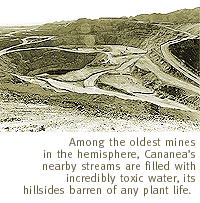 In a sign of changing times, however, last month's flurry comes
a mere nine years after infamous former Mexican President Carlos
Salinas squashed an operative labor contract at the mine. He dispatched
3,000 soldiers to make his point, and eventually sold the nationally-owned
operation to Grupo Mexico, a company headed by Salinas' late amigo,
Jorge Larrea.
In a sign of changing times, however, last month's flurry comes
a mere nine years after infamous former Mexican President Carlos
Salinas squashed an operative labor contract at the mine. He dispatched
3,000 soldiers to make his point, and eventually sold the nationally-owned
operation to Grupo Mexico, a company headed by Salinas' late amigo,
Jorge Larrea.
Notoriously anti-union, Grupo Mexico produces nearly 95 percent
of Mexico's copper, along with controlling railroads and several
other industries.
Though settled somewhat peacefully, the recent strike represents
a shaky political deal that many rank-and-file members of Sindicato
65, the miners' local, consider a sell-out by their top brass.
THE UPRISING BEGAN November 19, after Grupo Mexico announced
a brutal restructuring at Cananea. The plan included layoffs of
up to 1,000 of the mine's 2,070 employees, closure of groundwater
protection operations, severe limitation of retirement benefits
and the hatcheting of production bonuses.
As some 2,000 enraged workers walked off the job, they also raised
critical pollution and healthcare concerns at the facility, which
remains a major regional polluter. Among the oldest mines in the
hemisphere, Cananea's nearby streams are filled with incredibly
toxic water, its hillsides barren of any plant life. Now threatened
lay-offs would also include employees overseeing the mine's fledgling
ecological protections. That alone represents a blatant violation
of Mexico's environmental laws, along with admittedly weak clean-up
accords tied to the NAFTA agreement.
And there was another double-cross at hand: On the eve of the
strike, Grupo Mexico had hashed out a reasonable bargain with
workers--which it abandoned immediately after they voted its approval.
Still, technicalities prevailed. Since the workers didn't walk
out right after that initial vote, their ensuing strike was deemed
illegal, giving Grupo Mexico a firm upper hand. On February 13,
after an exhausting campaign to rally other national and international
unions to their side, desperate mineworkers forcefully occupied
many of the mine's facilities, protesting betrayal by their own
union leaders in Mexico City. The strike ended two days later
with a stroke of déja vu, when Mexican Army troops surrounded
the town and Judicial Police routed workers from the buildings.
The subsequent deal, signed after secret negotiations between
national-level union representatives, Grupo Mexico and the Secretary
of Labor, gave little if anything to the miners. But those at
the top benefited quite nicely.
According to Jesus Romo-Vejar, a Tucson attorney working with
the strikers, the settlement finalized a high-stakes political
game that put feathers in the caps of Interior Minister Francisco
Labastida Ochoa, mentioned as a possible successor to President
Ernesto Zedillo, and Mexican Labor Minister José Antonio
González Fernández, a contender to head the ruling
national PRI party.
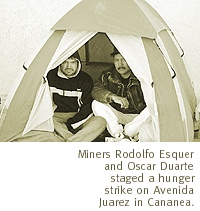 It also placed union leaders in good stead with the country's
power brokers. "There was obviously a sell-out by the National
Union in Mexico City," Romo-Vejar says. "They essentially
dictated the terms of the settlement, and it was very disastrous.
Symbolically, this union is extremely important in Mexico. Now
the one who benefits most is Ochoa. Zedillo is finishing his term,
and he's expressed a desire that Ochoa be his successor. Had Ochoa
lost the strike, he'd have been out of the picture."
It also placed union leaders in good stead with the country's
power brokers. "There was obviously a sell-out by the National
Union in Mexico City," Romo-Vejar says. "They essentially
dictated the terms of the settlement, and it was very disastrous.
Symbolically, this union is extremely important in Mexico. Now
the one who benefits most is Ochoa. Zedillo is finishing his term,
and he's expressed a desire that Ochoa be his successor. Had Ochoa
lost the strike, he'd have been out of the picture."
So far, approximately 350 workers have accepted their severance
packages and joined the fight. Other unemployed men now haunt
Cananea street corners, and many more have given up completely,
leaving Cananea for other Mexican cities or the United States.
But a hardcore contingent remains to fight against daunting odds.
Their challenge only grew when the mine, long-mandated to provide
water and electricity to the town, abandoned its responsibilities
and left the city of roughly 50,000 in the dark.
Still, there was a ray of hope to the north. It broke through
on February 16, when the newborn North American coalition staged
a rally outside the Tucson headquarters of ASARCO, Inc., the huge
mining conglomerate that owns a chunk of Grupo Mexico.
A board noting that day's ore prices hung in the otherwise empty
lobby of ASARCO's austere cement building on North Fifth Street.
Edgy United Parcel workers occasionally scurried through the doors,
while outside Rene Enriquez León, representing Sindicato
65 of the Miners and Metallurgical Workers Union of Mexico, stood
blinking before an eclectic crowd of some 100 protesters to detail
the miners' plight.
León had already described how 500 government troops were
camped on the outskirts of Cananea, with the sole intent of intimidating
residents. He said plain-clothed police broke into his own house
on December 21, destroying personal documents and terrorizing
his family. At the same time, two union members in Mexico City
were chased by government agents. Following such hardball tactics,
several Sindicato 65 members have requested political asylum in
the United States. "Right now, my kids are very scared,"
León said.
Nonetheless, he kept a stiff upper lip. "Receive a greeting
from our friends in the mines," he told the crowd. "We
are still struggling and still fighting. We and our families have
been stepped on. But we're going to hold our heads up high because
we know we're right. We are glad to have you with us, on behalf
of all my brothers in Cananea."
As he spoke, two of those brothers were already preparing for
an equally arduous journey, a hunger strike smack in the middle
of Cananea's main drag.
The sun was setting on March 18, and temperatures were dropping
into the 30s when Rodolfo Esquer and Oscar Duarte skipped dinner
and prepared their beds on Avenida Juarez. "What the company
is doing to us is against the labor law and the constitution,"
said Esquer, sipping from a juice bottle. "If they're going
to starve us, why not starve right here in the middle of the street
where everyone can see it."
Just down the hill, between the two men and the mine, a pair
of Humvees loaded with army troops turned around at a police tape
stretching across the road. A lone black-clad police sentry stood
guard at the roadblock, waving honking cars through a detour.
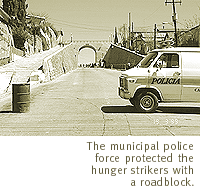 AMONG THE MINERS who still have their jobs, many claim
the mine hasn't complied with the bulk of the agreement, including
paying a production bonus. In some cases weekly wages have been
slashed by 75 percent. According to Gemma Lopez Limon of the Ricardo
Flores Magon Human Rights Committee (named after the Flores Magon
brothers, Industrial Workers of the World hell-raisers who sparked
the 1907 strike) some miners are receiving as little as $2 a week
after the company charged them for damages blamed on the strike.
AMONG THE MINERS who still have their jobs, many claim
the mine hasn't complied with the bulk of the agreement, including
paying a production bonus. In some cases weekly wages have been
slashed by 75 percent. According to Gemma Lopez Limon of the Ricardo
Flores Magon Human Rights Committee (named after the Flores Magon
brothers, Industrial Workers of the World hell-raisers who sparked
the 1907 strike) some miners are receiving as little as $2 a week
after the company charged them for damages blamed on the strike.
"We aren't from the departments they closed," Esquer
said. "In any case, they won't even pay the severance the
union agreed to, for those who are. They are committing a very
grave mistake."
The hunger strike is just one among many continuing skirmishes
between workers and the company. On March 18, small groups spent
the day blocking the mine's many entrances, preventing service
vehicles and outside hires from entering. In nearby offices, company
officials wouldn't talk to reporters or leave their doors, accusing
the miners of plotting to kidnap them.
"We are workers, not kidnappers," laughed one of the
unemployed men.
Miners' wives also got involved. On March 15, only days after
the mining company shut off water to several barrios, 60 members
of the Women's Front of Cananea--a 1,000-strong mutual aid society
made up mostly of workers' spouses--led hundreds of residents
who commandeered two water-pumping facilities. "We just marched
up and declared that this water belongs to the town of Cananea,
and opened the tap," said Grizelda Quijada Denogean, a 32-year-old
mother of three. They held the facilities until the company shut
off the main and all electrical power 48 hours later.
According to the Sonoran Constitution, the mine provides potable
water for residents, in exchange for unlimited use of water to
process copper. Turning it off was considered an act of revenge.
While residents ran foul sludge from household taps, the company
arrogantly pumped good water into the mines. For nine days those
who could afford it bought bottled water from nearby Agua Prieta.
Others strapped for cash drank the shitty water and became violently
ill.
Holding up a bottle of rancid liquid from a neighbor's kitchen
sink, Rosa Guayante called it an outrage. She rattled off names
of friends whose children had been puking for days. "What
is more violent than starving a baby or letting all of the children
get sick from bad water?" she asked. "Are the army or
the police any worse?"
"They're killing us slowly," echoed Diana Santillanes,
another wife and 32-year-old mother of three. "This is against
the community, not just the union."
Not surprisingly, such stories have been dismissed by local health
officials as fabrications or exaggerations. As a result, the Women's
Front took their case straight to the federal government. They
spent that week canvassing Cananea's barrios for oral testimonies
from the sick, then presented their documentation to the Federal
Public Ministry as a legal petition.
 During the strike, women also updated residents over the airwaves
of a local radio station. And when gas was turned off to several
of the poorest parts of town in January, they stormed local schools,
closing classes to thousands of students. They bitterly noted
that the Governor of Sonora, a Cananea native, hasn't lifted a
finger in their defense. "How can he sell out his own people?"
Grizelda Quijada asked.
During the strike, women also updated residents over the airwaves
of a local radio station. And when gas was turned off to several
of the poorest parts of town in January, they stormed local schools,
closing classes to thousands of students. They bitterly noted
that the Governor of Sonora, a Cananea native, hasn't lifted a
finger in their defense. "How can he sell out his own people?"
Grizelda Quijada asked.
Three friends of the hunger strikers offered a sarcastic response.
"The Governor, Larrea and President Zedillo are having a
tequila together right now," one of them joked without smiling.
"Make no mistake, this is all the fault of the company,"
said Mayor Francisco Garcia Gamez. "That's why we are so
actively looking for ways to decrease Cananea's dependence on
the company for services and for sources of local employment.
We need to diversify."
His first plans are to procure government funds for a waterworks
independent of the mine. His constituents call that just another
pipe dream, pointing out that most Cananea wells are dry, and
the mine has polluted other water sources like the San Pedro and
Sonora Rivers.
Garcia Gamez is also pumping the positive aspects of his town
for business. Whether he grasped the irony isn't clear, but stacked
on his desk were slick, full-color pamphlets printed in English
and cheerfully titled, "Cananea: your best investment for
the 21st Century."
While the Mayor's optimism wasn't disingenuous, he admitted that
attracting new business is tough, considering the current troubles
and long history of labor problems.
But at least there's comeuppance from a higher source: Grupo
Mexico owner José Larrea died March 20 at age 82. Unfortunately,
company reins are now in the hands of his son Herman, who many
Cananeans fear may be even greedier.
"Grupo Mexico is a pulpo [octopus]," said Hernan
Arballo, a Mexico environmentalist and organizer of the "Group
of 719," a political contingent of miners fired in the 1989
strike. "They're trying to strangle this community so they
can bring in workers from the outside and pay them less. Larrea
wants people who don't have the organizational experience we have."
In support of the struggle, Arballo, who is also the local Boy
Scout leader, brought out sleeping bags for Esquer and Duarte.
Despite the people's feelings towards Grupo Mexico, the "pulpo"
is a fact of life in Sonora, reportedly owning everything
from railroads and port facilities to copper mines throughout
the state.
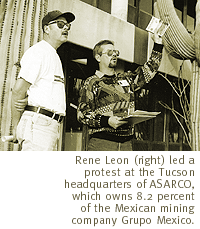 According to reports, the company is also trying to buy the ports
of Guaymas and Ensenada in Baja California.
According to reports, the company is also trying to buy the ports
of Guaymas and Ensenada in Baja California.
Adding another layer of insult, the London-based Financial
Times recently quoted a Grupo Mexico official bragging that,
far from harming the company, the Cananea strike actually helped
by allowing surplus copper produced more cheaply elsewhere to
be sold at higher prices.
Since neither hunger strikes nor picket lines are likely to pierce
that veil of power, many residents are looking at simply moving
on. "There is no future in Cananea," said teary-eyed,
21-year-old Mirna Luna, a mother and miner's wife. Nevertheless,
Luna plans to stay, at least for a while.
Later, under the bridge, the hunger strikers were getting a check-up
by medics as friends and fellow workers trickled by to offer handshakes,
hugs and promises of help. Neither Esquer, who has three young
children and another on the way, nor Duarte, who supports his
wife and four youngsters, has been paid in over four months. Like
thousands of others in Cananea, they survive on informal goodwill,
and dwindling donations from a network of churches, human rights
groups and other unions.
"Things are quickly getting worse now," notes Diana
Santillanes, a 32-year-old mother and Women's Front member. "It's
almost the 21st century. And Cananea is going to enter it moving
backwards."
BACK IN TUCSON, three workers were inadvertently revealing
how the Grupo Mexico/government cabal was starting to fracture
Sindicato 65's unity. On March 19, Rene León, Reynaldo
Palomino and Martin Sanchez gathered in the El Rio Neighborhood
Center, where they briefed a restive audience.
"Our labor movement has lasted 84 days, and one of the things
we wanted was to rescue our labor contract, which we did,"
Palomino said. "The agreement was that nobody would be fired.
Three departments would be closed, and those people would be relocated.
The rank-and-file approved it, and we found out shortly thereafter
that the company refused to comply with it.
"Then they closed the water plant, leaving the city without
water for five days," he said. "We asked ourselves why
they did this. The answer: Grupo Mexico is angry that the entire
township of Cananea was against them. And now there are 151 workers
the company refuses to allow in. These were the people most involved
in (local) leadership of the strike. The company obviously retaliated
against them."
Grupo Mexico is also incensed that Sindicato 65 has garnered
support from groups in the United States, he said. "But the
message from our union president is that, thanks to the participation
of the international unions, we were able to save the contract.
The conflict is not over yet."
León then asked for assistance from American human rights
groups. "If (the hunger strikers) don't get answers by tomorrow,
then there will be an additional 10 people joining them,"
he said.
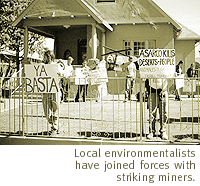 But it was Sanchez who heaved the sharpest barbs. After distancing
himself from union leaders over the scandalous contract, he moved
to Tucson where--unlike León and Palomino--he's safe from
direct retaliation for his words.
But it was Sanchez who heaved the sharpest barbs. After distancing
himself from union leaders over the scandalous contract, he moved
to Tucson where--unlike León and Palomino--he's safe from
direct retaliation for his words.
He quickly described the strike settlement as "disastrous."
It was "forced upon us," he said, "and that is
the truth. We feel betrayed. It looks like we'll go back on strike,
and the hunger strike is also expanding."
Like the ASARCO rally, the El Rio meeting drew strange
bedfellows indeed, with beefy miners mingling uncomfortably among
the rambunctious environmentalists. And it's by no means certain
this shaky coalition can hang tough: Hinging on a specific issue
at a particular time, such groups tend to have the durability
of cheap crystal.
Addressing the ASARCO crowd a few weeks earlier, Arizona Earth
First! spokesman Dwight Metzger had nonetheless trumpeted a lasting
cross-border fight. "We're out here in solidarity with the
mineworkers of Cananea to restore environmental sanity to the
Sonoran Region," he hollered into a megaphone. "For
100 years, Cananea has been operating without any environmental
regulations, and the situation there is catastrophic. And it will
impact many generations to come."
While aligning with miners presents a new twist for his group,
"The firing of 135 environmental workers is what actually
precipitated the strike," Metzger said. "The workers
realize their families are being poisoned, and that they themselves
are victims of environmental injustice.
"As for ASARCO, they own a small percentage but have a major
interest in the ore that's produced in Cananea to feed their Hayden
(Arizona) smelter. For example, if a similar situation were to
happen with ASARCO here, they could fall back on Cananea for a
constant source of ore. Hayden is also going to play itself out
at some point, but Cananea has at least 30 years left. And remember
that ASARCO is considered Arizona's number one polluter."
(ASARCO spokesman Jerry Cooper, based in New York, says the company
currently owns 8.2 percent of Grupo Mexico, adding that the small
share gives his company little control over Cananea).
Daniel Patterson, of the Southwest Center for Biodiversity,
also spouted the ecological line. "It became clear when the
miners came to Tucson seeking out environmentalists," he
said, "that environmental issues were a major reason for
the strike. We're concerned about the major impacts to the Rio
Sonora, and the San Pedro, which flows into Arizona. And we stand
united with the workers to bring these lawless corporations into
compliance with their own environmental laws."
The Southwest Center may throw a legal wrench in the works, based
on NAFTA's environmental side-agreements, he said. "Right
now we're looking across the border at the entire Sonoran bioregion,
to start cooperating with workers on both sides against corporate
greed."
He then glanced at the silent, towering ASARCO building, and
chuckled. "Actually, the ASARCO workers here might be pretty
happy with us already," he said. "It looks like they
got a paid day off."

|





